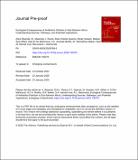Ecological Consequences of Antibiotics Pollution in Sub-Saharan Africa: Understanding Sources, Pathways, and Potential Implications

View/
Date
2025-01-25Author
Ripanda, Asha
Rwiza, Mwemezi
Nyanza, Elias
Hossein, Miraji
Alfred, Mateso
Mahmoud, Alaa
Murthy, Ananda
Bakari, Ramadhani
Vuai, Said
Machunda, Revocatus
Metadata
Show full item recordAbstract
In Sub-Saharan Africa (SSA), the increasing use of antibiotics in human and veterinary medicine, combined with inadequate waste and water management systems, has intensified the problem of antibiotic pollution. Untreated or partially treated wastewater from industries, agricultural runoff, residential areas, and healthcare facilities is frequently discharged into the environment, often used for irrigation, contributing to antibiotic accumulation, the spread of resistance genes, and the rise of antibiotic resistance, posing serious threats to public health and environmental sustainability. The region's climatic conditions favour the survival and proliferation of microbial communities, including pathogens. Additionally, the high prevalence of infectious diseases such as HIV/AIDS, tuberculosis, and malaria, which often necessitate antibiotic use, further amplifies the issue. Systemic challenges, including poor waste management, inadequate or absent wastewater treatment infrastructure, weak regulatory enforcement, and the over-the-counter sale of antibiotics, exacerbate the crisis. Limited healthcare access often results in self-medication and improper antibiotic use, accelerating resistance spread. Evidence shows antibiotics in surface water, groundwater, effluents, food crops, environmental samples, and aquatic organisms, indicating their potential circulation through the food chain. However, a lack of comprehensive data on antibiotic pollution and its impacts on aquatic ecosystems in SSA hampers a thorough understanding of its scope and long-term effects. Addressing this crisis requires identifying contamination hotspots, evaluating ecological impacts, and establishing robust, region-specific regulatory frameworks to ensure environmental and public health safety
URI
https://doi.org/10.1016/j.emcon.2025.100475https://dspace.nm-aist.ac.tz/handle/20.500.12479/2877
